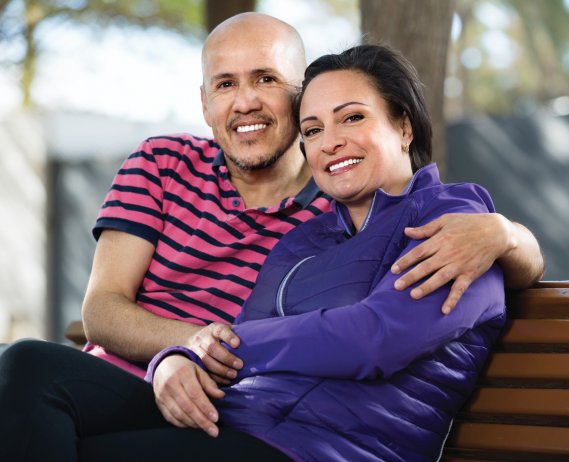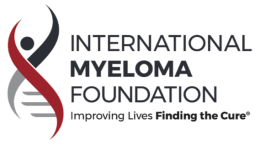The Need for Myeloma Treatment
The first treatment for active myeloma is called frontline treatment, or induction treatment. Results of tests, called baseline or diagnostic tests, must be carefully reviewed by your doctor(s) and healthcare team. Your team will determine if starting treatment is necessary. This decision is based upon results of a biopsy that indicates the presence of myeloma in the bone marrow, or tissue, as well as on other disease indicators (See What Is Multiple Myeloma? for more details about these disease indicators.)
What Are Some Reasons to Begin Treatment for Your Myeloma?
Sometimes, emergency medical situations such as kidney failure, increased blood calcium, increased pressure on the nerves or spinal cord, for example, may require immediate medical attention. For most patients, there is not an immediate emergency, but a need to prevent further medical complications such as anemia, infections, bone damage and/or the general impact of active myeloma.
Why You Should Consult with a Myeloma Expert?
If you or your family have questions, this is an important time to consider consulting with a myeloma expert. A myeloma expert can confirm your diagnosis and recommend next steps.
Frontline Treatment Options for Multiple Myeloma
In 2023, the recommended options are very straightforward and are known as the Standard of Care (SOC).
These SOC options are based upon the results of phase III trials in which one therapy has shown to be better than other therapies. Shared decision-making with your doctor and healthcare team will determine your choice of treatment options. Together, you may consider a treatment’s benefits and side effects.
You might also discuss concerns about your expected quality of life, the impact on your career if you are still working, and the impact of treatment on other life activities. The cost of care may also be a consideration for you.
Primary Standard of Care: Triplet or Doublet Options
For Transplant-Eligible Patients
For younger and healthy individuals, it is important to retain the option of autologous stem cell transplant. In this setting, the first-line of therapy is Velcade® (bortezomib), Revlimid® (lenalidomide), and dexamethasone, or VRd. Learn more about VRd here.
These drugs will be administered as follows:
- Velcade by subcutaneous injection
- Revlimid as a pill taken by mouth)
- Dexamethasone, a steroid taken as a pill by mouth.
If Revlimid is not available, other recommend first-line options are the following:
- Velcade, Thalomid® (thalidomide), and dexamethasone (VTd): This combination is administered similar to the VRd combination. Thalomid is an immunomodulatory drug (IMiD) and can be taken as a pill by mouth as well.
- Velcade, Cytoxan® (cyclophosphamide), dexamethasone (VCd). Cytoxan is an alkylating agent that can be taken as a pill by mouth.
For frail patients and/or if access to drugs is a challenge, these combinations may be considered:
- Revlimid and dexamethasone (Rd)
- Velcade and dexamethasone (Vd)
- VRd Lite, which means the patient will take a VRd regimen with lighter doses of each drug to improve tolerance
The algorithm, developed by Dr. S. Vincent Rajkumar of the Mayo Clinic (Rochester, MN), provides a visual of the treatment options for transplant-eligible multiple myeloma patients.
For Transplant-Ineligible Patients
When there is no plan for an autologous stem cell transplant, the recommended therapy is Darzalex® (daratumumab), Revlimid, and dexamethasone, or DRd. This triplet therapy is also known as the MAIA regimen.
The MAIA regimen has demonstrated excellent results. Some patients may undergo DRd; or Darzalex Faspro® (a subcutaneous injection of Darzalex), Revlimid by mouth, and dexamethasone by mouth.
If transplant is being considered, some doctors may recommend the MAIA regimen. In general, VRd is preferred for patients with higher risk disease.
The algorithm, developed by Dr. S. Vincent Rajkumar of the Mayo Clinic (Rochester, MN), provides a visual of the treatment options for transplant-ineligible multiple myeloma patients.
The Use of Four Drugs for Frontline Treatment
New data indicate that four drugs (quadruplet therapy) may provide deeper and longer remissions as opposed to using three drugs (triplet therapy). However, more follow-up data are required before this becomes a standard of care (SOC).
Your doctor may discuss the option with you, especially if chromosome (FISH) testing has shown high-risk features. If that is the case, early relapse is more likely. Four-drug combinations that may be considered include the following:
Darzalex, Sarclisa® (isatuximab) with VRd, VTd, or VCd.
As noted below, KRd may be used instead of VRd in patients with higher risk features such as FISH abnormalities and/or plasma cell leukemia or myeloma occurring in soft tissue areas (extramedullary—or outside the bone).
What Are the Expectations with Frontline Treatment?
A majority of patients achieve excellent responses that occur within the first 2-3 months of treatment. This response is tracked by measuring the myeloma protein levels (also known as the M-component, spike, or M-protein) each month. A fifty-percent reduction in M-protein indicates a partial response. At this level, a patient is said to have responded.
When response continues to 75%, it is known as very good partial response, or VGPR. If the response shows a 100% reduction in M-protein— such that the M-protein is no longer detectable by traditional methods (SPEP or IFE tests), then it is known as complete response or CR.
What Is Considered a Remission in Multiple Myeloma?
Remission is said to be achieved when the response is sustained or deepens over a period of months. That response is a 50% reduction in myeloma protein level. Around the six-month mark, frontline treatment will have been completed, and the patient’s myeloma will be re-evaluated.
The expectation is that response and remission will last an average of 4-5 years, especially patients with good risk. For higher risk patients in whom remission have lasted fewer than one year, some adjustments to frontline therapy may be made to improve responses. For example, your doctor may substitute Kyprolis® (carfilzomib) in KRd with Velcade, or your doctor may consider using four drugs (a quadruplet) such as Dara + KRd. Sustained, ongoing therapy is also recommended.
Improvement in Myeloma Symptoms
Typically, myeloma symptoms improve as the response to treatment progresses. For example, CRAB features (Calcium levels, Renal/Kidney function, Anemia, and Bone health) substantially correct during the first months of treatment. (See What Are MGUS, Smoldering Multiple Myeloma, and Active Myeloma? for more details about the CRAB criteria). As a patient, you will track your own symptoms and your doctor(s)/healthcare team will test monthly for calcium levels, creatinine levels (kidney function), and hemoglobin levels (anemia), as well as any necessary imaging scans (X-rays, MRIs, or CT scans as recommended by your doctor). If significant bone damage has occurred, associated pain and other issues may take longer to resolve.
Side Effects of Treatment
Typically, VRd or Dara + Rd (or alternate combinations) are very well tolerated. These therapies are very different than older chemotherapy schedules. There is still a concern about nerve irritation/damage (neuropathy) with Velcade (bortezomib)—the likelihood of which increases over time. It is very important for patients to immediately report any side effects that they are experiencing. See the FDA-Approved Drugs for Myeloma page and corresponding drug pages for their indications and potential side effects.
What's Next?
Learn about what factors you and your healthcare team should consider to determine if you are eligible for a stem cell transplant. Also, gain an understanding of the transplant procedure.
The International Myeloma Foundation medical and editorial content team
Comprised of leading medical researchers, hematologists, oncologists, oncology-certified nurses, medical editors, and medical journalists, our team has extensive knowledge of the multiple myeloma treatment and care landscape. Additionally, Dr. Brian G.M. Durie reviews and approves all medical content on this website.
Last Medical Content Review: February 2, 2022










